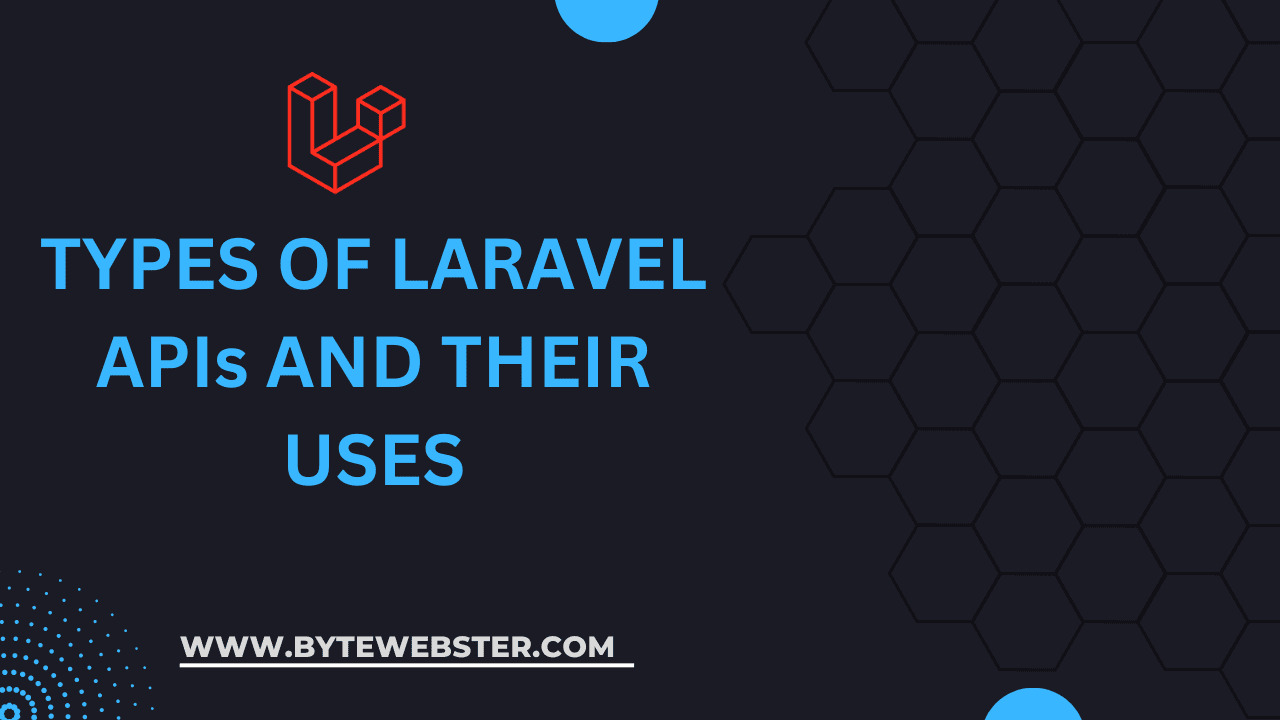Types of Laravel APIs and Their Uses with Example

What is the use of APIs in Laravel?
APIs, or application programming interfaces, allow different applications to communicate with each other. In Laravel, APIs can be used to build web-based services that can be consumed by external applications.
These services can include things like retrieving data from a database, processing data, and performing other operations that can be accessed through a standardized set of endpoints. This allows for easy integration with other systems and can be used to build powerful and flexible systems.
Laravel is a PHP web application framework that provides a set of tools for building web applications.
The framework includes several types of APIs that can be used for different purposes, including:
1. RESTful API
A RESTful API in Laravel uses HTTP requests to GET, PUT, POST and DELETE data. Laravel makes it easy to build a RESTful API by providing built-in support for several features needed to build such an API.
A simple example of a RESTful API in Laravel could be a route that allows a client to create a new resource (e.g. a new user in a database) by making a POST request to the server.
Here is an example of how to create a new resource using the Laravel framework:
Route::post('/users', 'UserController@store');
public function store(Request $request)
{
// Validate the request data
$validatedData = $request->validate([
'name' => 'required|max:255',
'email' => 'required|unique:users|email',
'password' => 'required|min:6',
]);
// Create a new user and save it to the database
$user = new User;
$user->name = $validatedData['name'];
$user->email = $validatedData['email'];
$user->password = Hash::make($validatedData['password']);
$user->save();
// Return a 201 status code to indicate that the resource was created successfully
return response()->json($user, 201);
}
This is just a simple example. Laravel has a lot of in-built functionality for handling RESTful APIs, such as handling authentication, handling errors, and much more.
2. GraphQL API
In Laravel, you can use the package called "graphql-php" to implement a GraphQL API. Here is an example of how to set up a basic GraphQL API in a Laravel app:
use GraphQL\Type\Schema;
use GraphQL\GraphQL;
use GraphQL\Type\Definition\ObjectType;
use GraphQL\Type\Definition\Type;
class GraphQLController extends Controller
{
public function query(Request $request)
{
// Define the schema
$queryType = new ObjectType([
'name' => 'Query',
'fields' => [
'hello' => [
'type' => Type::string(),
'resolve' => function() {
return 'Hello World!';
}
]
]
]);
$schema = new Schema([
'query' => $queryType
]);
// Execute the query
$query = $request->input('query');
$result = GraphQL::executeQuery($schema, $query);
return $result->toArray();
}
}
Route::post('/graphql', 'GraphQLController@query');
This is a basic example that defines a single "hello" field in the schema and returns the string "Hello World!" when that field is queried. You can add more fields and types to the schema to create a more complex API.
3. WebSockets API
In Laravel, you can use the package called "laravel-websockets" to implement a WebSockets API.
This type of API allows for real-time, two-way communication between the client and the server. It is often used for chat applications, real-time updates, and other features that require quick response times.
Here is an example of how to set up a basic WebSockets API in a Laravel app
php artisan vendor:publish --provider="BeyondCode\LaravelWebSockets\WebSocketsServiceProvider" --tag="config"
php artisan migrate
use BeyondCode\LaravelWebSockets\WebSockets\Channels\ChannelManager;
class WebSocketsController extends Controller
{
public function onMessage(ChannelManager $channelManager, $data)
{
$channelManager->broadcast($data);
}
}
Route::post('/websockets/message', 'WebSocketsController@onMessage');
This is a basic example that handle the message and broadcast it to all connected clients. You can customize the behavior of your WebSockets API by defining different events and handling them in different ways, you can also use it to create a chat application, real-time notifications, and more.
4. Event Broadcasting API
In Laravel, you can use the built-in event broadcasting feature to implement an API for event-based communication. This type of API allows you to easily broadcast events to various listeners, such as JavaScript clients or queue workers.
Here is an example of how to set up a basic event broadcasting API in a Laravel app
class MyEvent extends Event
{
use SerializesModels;
public $data;
public function __construct($data)
{
$this->data = $data;
}
}
class MyController extends Controller
{
public function triggerEvent(Request $request)
{
event(new MyEvent($request->input('data')));
}
}
Route::post('/event/trigger', 'MyController@triggerEvent');
This is a basic example that handle the message and broadcast it to all connected clients. You can customize the behavior of your event broadcasting API by defining different events and handling them in different ways, you can also use it to create real-time notifications, and more.
5. Task Scheduling API
The task scheduling feature in Laravel allows you to schedule repetitive tasks, such as sending emails or cleaning up old data, to run automatically at specified intervals. This can be done using the built-in task scheduler that comes with Laravel, which is based on the popular cron scheduling system.
Here is an example of how to use the task scheduling API in Laravel:
$schedule->command('mytask')->hourly();
$schedule->artisan('my:command')->daily();
$schedule->call(function () {
// code to run
})->daily();
php artisan schedule:run
This will run all of your scheduled tasks at the specified intervals.
This is a basic example of how to use the task scheduling API in Laravel. You can find more information about the available scheduling options and methods in the Laravel documentation.